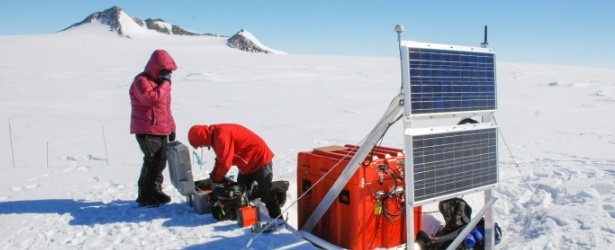Antarctic icequakes triggered by 2010 magnitude 8.8 Chile earthquake

Sections of Antarctica's frozen desert can experience hundreds of micro-quakes an hour due to ice deformation. These quakes are also called icequakes and they are a usual occurrence on Antarctica. However, after the 8.8-magnitude earthquake that hit Chile in March 2010 Antarctica's icesheats vibrated a bit more than usual. The event was investigated by scientists from Georgia Institute of Technology which indicated in their new study that Antarctica's frozen ground is sensitive to seismic waves from distant earthquakes.
To study the quake’s impact on Antarctica, the Georgia Tech team looked at seismic data from 42 stations in the six hours before and after the 3:34 a.m. event. The researchers used the same technology that allowed them to “hear” the seismic response at large distances for the devastating 2011 magnitude 9 Japan earthquake as it rumbled through the earth. In other words, they simply removed the longer-period signals as the seismic waves spread from the distant epicenter to identify high-frequency signals from nearby sources. Nearly 30 percent (12 of the 42 stations) showed clear evidence of high-frequency seismic signals as the surface-wave arrived on Antarctica.

High-frequency icequakes at station HOWD in Antarctica during the distant waves of the 2010 magnitude 8.8 Chile earthquake. The triggered icequakes are indicated by the narrow vertical bands in the middle and lower sections of the graphic. They begin when the P wave arrives approximately 8 minutes (480 seconds) after the Chilean quake and continue through the arrival of the Rayleigh waves. The sound is generated by speeding up the HOWD's seismic data 100 times.
“We interpret these events as small icequakes, most of which were triggered during or immediately after the passing of long-period Rayleigh waves generated from the Chilean mainshock,” said Zhigang Peng, an associate professor in the School of Earth and Atmospheric Sciences who led the new study published in Nature Geoscience on August 10, 2014.
“This is somewhat different from the micro-earthquakes and tremor caused by both Love and Rayleigh-type surface waves that traditionally occur in other tectonically active regions thousands of miles from large earthquakes.
Peng says the subtle difference is that micro-earthquakes respond to both shearing and volumetric deformation from distant events. The newly found icequakes respond only to volumetric deformation.
“Such differences may be subtle, but they tell us that the mechanisms of these triggered icequakes and small earthquakes are different,” Peng added. “One is more like cracking, while the other is like a shear slip event. It’s similar to two hands passing each other.”
Some of the icequakes were quick bursts and over in less than one second. Others were long duration, tremor-like signals up to 10 seconds. They occurred in various parts of the continent, including seismic stations along the coast and near the South Pole.
The researchers found the clearest indication of induced high-frequency signals at station HOWD near the northwest corner of the Ellsworth Mountains. Short bursts occurred when the P wave hit the station, then continued again when the Rayleigh wave arrived. The triggered icequakes had very similar high waveform patterns, which indicates repeated failure at a single location, possibly by the opening of cracks.
Peng says the source locations of the icequakes are difficult to determine because there isn’t an extensive seismic network coverage in Antarctica.
“But at least some of the icequakes themselves create surface waves, so they are probably formed very close to the ice surface,” he added. “While we cannot be certain, we suspect they simply reflect fracturing of ice in the near surface due to alternating volumetric compressions and expansions as the Rayleigh waves passed through Antarctica’s frozen ice.”


High-frequency icequakes at station AGO (near the South Pole) in Antarctica during the distant waves of the 2010 magnitude 8.8 Chile earthquake. The triggered icequakes are indicated by the narrow vertical bands in the middle and lower sections of the graphic. They begin when the P wave arrives approximately 10 minutes (600 seconds) after the Chilean quake and continue through the arrival of the Rayleigh waves. The sound is generated by speeding up the AGO's seismic data 100 times.
Source: Georgia Institute of Technology
Reference:
"Antarctic icequakes triggered by the 2010 Maule earthquake in Chile"- Zhigang Peng, Jacob I. Walter, Richard C. Aster, Andrew Nyblade, Douglas A. Wiens & Sridhar Anandakrishnan – Nature Geoscience, (2014) – doi:10.1038/ngeo221
Featured image: The HOWD seismic station in Antarctica. Photo: Erik Kendrick, Ohio State University

Commenting rules and guidelines
We value the thoughts and opinions of our readers and welcome healthy discussions on our website. In order to maintain a respectful and positive community, we ask that all commenters follow these rules:
We reserve the right to remove any comments that violate these rules. By commenting on our website, you agree to abide by these guidelines. Thank you for helping to create a positive and welcoming environment for all.